|
General Metalware and Holloware
 |
Jones Brothers & Co
Ablow Street |
 |
They have long been many Joneses in Wolverhampton, doubtless
reflecting the large amount of immigration that took place from Wales.
The company we are concerned with here was named after three brothers,
William Highfield Jones, Benjamin Jones and Harry Jones.
 William Highfield Jones in aldermanic
robes. He was Mayor of Wolverhampton 1873 - 1874.
William Highfield Jones in aldermanic
robes. He was Mayor of Wolverhampton 1873 - 1874. |
W. H. Jones was somewhat given to writing books and produced at least
three:
History of the Congregational Churches of Wolverhampton from the
year 1662 to 1894, 1894
Story of the Municipal Life of Wolverhampton, 1903
Story of Japan, Tin-Plate Working and Bicycle and Galvanising Trades
in Wolverhampton, 1900
These works provide an exceptional source of Wolverhampton
history but have to be treated with some caution - not only are
they short on hard dates but they tend towards being
hagiographic. This caution needs to be liberally applied in a
case like the present, where the information about the Jones
brothers is taken almost exclusively from the books written by
one of them. |
| The father of the three brothers was a foreman at
the Old Hall japanning works for 25 years and all three brothers
served their apprenticeships - presumably as japanners - at the
Old Hall.
The oldest brother, William, set up in business on his own
account, renting some workshops near the National School,
Cleveland Street. |
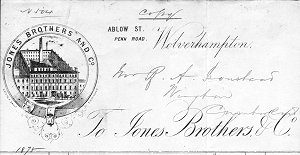
Invoice heading, dated 1875. |
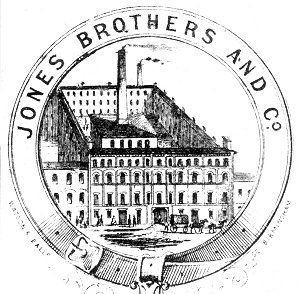 The factory, taken from the invoice
heading shown above. The buildings are improbably thin.
This must be the original Welling works; the extensions would
have been to the right.
The factory, taken from the invoice
heading shown above. The buildings are improbably thin.
This must be the original Welling works; the extensions would
have been to the right. |
There the other two brothers joined him in due course. They
then bought a factory in Ablow Street, which had been built by
the japanner Thomas Welling and which had been empty for some
time.
The exact dates of these moves is not recorded but William does
say that the firm was founded as Jones Bros. & Co. in 1853.
William mentions that Harry Jones, the youngest brother, "had a
genius for artistic design", so presumably it was he who
designed most, if not all, of their goods up until his death in
1871, aged 38. Who was responsible for design after that is not
known. |
| Benjamin Jones, the middle brother, seems to have
been the travelling salesman. Presumably, though he does not mention
it in his books, William, as the oldest brother and founder of the
business, took the business lead and would have acted as chairman of
the company and managing director.
Their trade grew and "in a few years … they found the factory
in Ablow Street was far too small, so they purchased adjoining
properties and built several new ranges of shopping". |
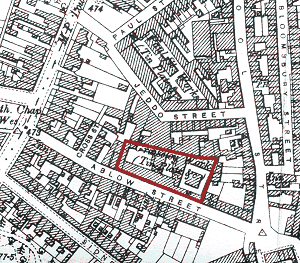
O.S. map, 1902, showing the Graiseley Works of Jones Brothers. |
|
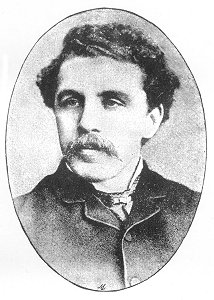 William Hall Jones.
William Hall Jones. |
At some time Benjamin's two sons, William Hall Jones and B.
Highfield Jones, joined the works and, as each reached 21, was taken
into the firm as a junior partner. "These young men pushed the trade
with enthusiasm and travelled over India, China and South Africa".
The firm opened a branch factory in Nelson Street, which dealt
exclusively with enamelled articles and pressed tin goods. "Here
they introduced machinery into the manufacture, which has
greatly helped their trade". This seems to have happened in the
late 1880s and seems to be rather late for starting to use
machinery.
|
In 1880-81 there was a strike in Birmingham and Wolverhampton
to enforce a closed shop. Jones Brothers joined in the fight
against the strike and, after five months, won it.
Benjamin Jones died in 1887.
In 1896 William retired. His last book, The Municipal Life of
Wolverhampton, was published in 1903 and the author was given as
"the late" W. H. Jones. Presumably he died in 1902.
The business was taken over by Benjamin's two sons, William and
Highfield, and was turned into a limited liability company,
Jones Brothers & Co., Wolverhampton, Limited.
| The photo (right) shows
Tempest Street. The building on the right is the William
Highfield Jones Memorial School. (In fact, this is the back.
The front, in white terracotta, holds the memorial name stone but is
now practically invisible). Presumably it was erected at the
cost of the two sons. |
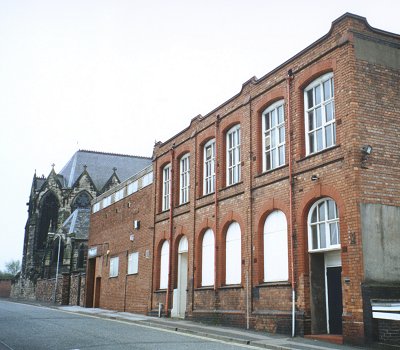
|
The company was still going in 1900 when William's book was
published.
John Tuckley says that his family's history records that John's
grandfather, William Henry Tuckley was a tinplate worker who worked with
Jones Brothers from 1910 to 1918. His work there included making
Jabecoe metal boxes, which were supposed to be unsinkable. The
trade mark attached to each showed an African man holding one of the
boxes. These boxes were presumably connected with the extensive
West African trade. William was a shop steward and lead a strike
at Jones Bros. when the firm started to employ women to make ammunition
belt boxes. These women were not replacing men who had left to
join the war but were employed simply because they were cheaper.
The men they replaced had to find work elsewhere and, if they did not,
had to join the army. He died in the flu epidemic of 1918.
His brother-in-law, Harry Yarsley, worked with him at Jones Bros. as a
sheet metal worker and left to join the Army in 1917 and subsequently
saw service in Dublin.
The rest of the company's later history is not known. They appear as
hollowware manufacturers in the Red Books up until 1930 but by 1936 have
dropped out.
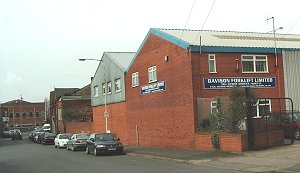
|
Ablow Street today.
Jones's works would have been on the site of the modern factory
and down as far as the next building. |
|

|

|
|
Return to metalware manufacturers |
Proceed to Jones
Bros' products |
|


 William Highfield Jones in aldermanic
robes. He was Mayor of Wolverhampton 1873 - 1874.
William Highfield Jones in aldermanic
robes. He was Mayor of Wolverhampton 1873 - 1874.
 The factory, taken from the invoice
heading shown above. The buildings are improbably thin.
This must be the original Welling works; the extensions would
have been to the right.
The factory, taken from the invoice
heading shown above. The buildings are improbably thin.
This must be the original Welling works; the extensions would
have been to the right.
 William Hall Jones.
William Hall Jones.


